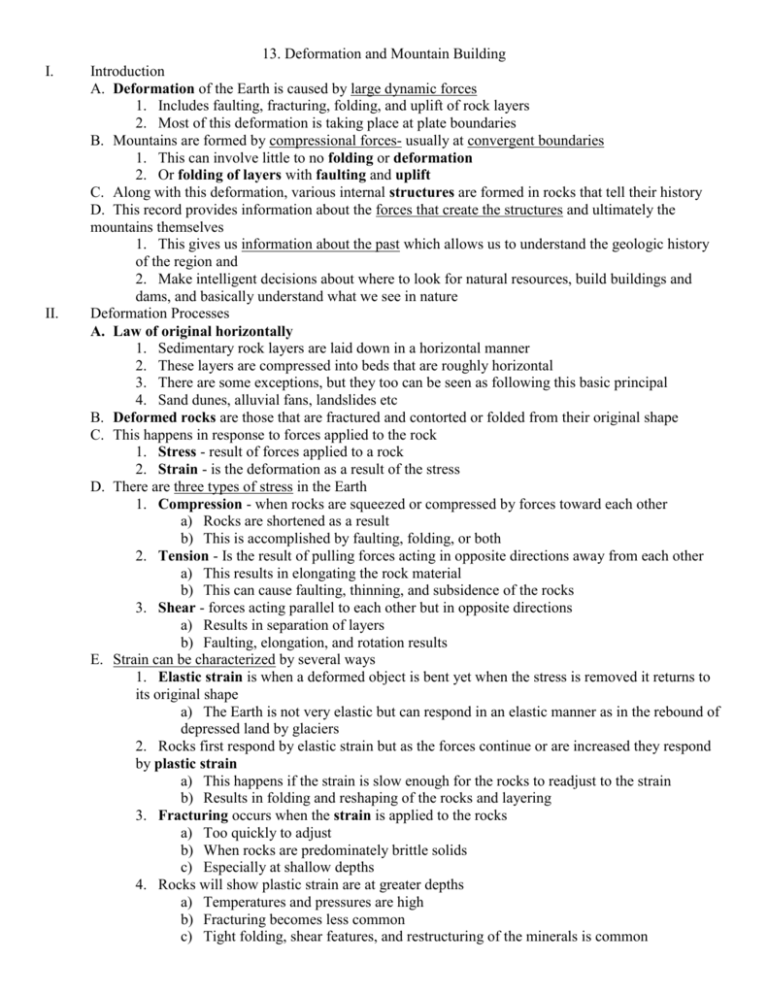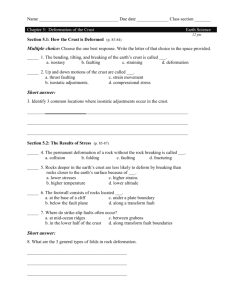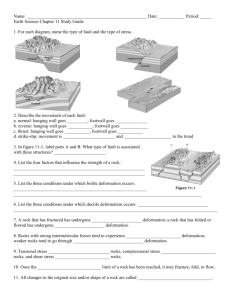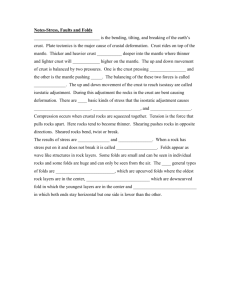13. Deformation and Mountain Building
advertisement

13. Deformation and Mountain Building I. II. Introduction A. Deformation of the Earth is caused by large dynamic forces 1. Includes faulting, fracturing, folding, and uplift of rock layers 2. Most of this deformation is taking place at plate boundaries B. Mountains are formed by compressional forces- usually at convergent boundaries 1. This can involve little to no folding or deformation 2. Or folding of layers with faulting and uplift C. Along with this deformation, various internal structures are formed in rocks that tell their history D. This record provides information about the forces that create the structures and ultimately the mountains themselves 1. This gives us information about the past which allows us to understand the geologic history of the region and 2. Make intelligent decisions about where to look for natural resources, build buildings and dams, and basically understand what we see in nature Deformation Processes A. Law of original horizontally 1. Sedimentary rock layers are laid down in a horizontal manner 2. These layers are compressed into beds that are roughly horizontal 3. There are some exceptions, but they too can be seen as following this basic principal 4. Sand dunes, alluvial fans, landslides etc B. Deformed rocks are those that are fractured and contorted or folded from their original shape C. This happens in response to forces applied to the rock 1. Stress - result of forces applied to a rock 2. Strain - is the deformation as a result of the stress D. There are three types of stress in the Earth 1. Compression - when rocks are squeezed or compressed by forces toward each other a) Rocks are shortened as a result b) This is accomplished by faulting, folding, or both 2. Tension - Is the result of pulling forces acting in opposite directions away from each other a) This results in elongating the rock material b) This can cause faulting, thinning, and subsidence of the rocks 3. Shear - forces acting parallel to each other but in opposite directions a) Results in separation of layers b) Faulting, elongation, and rotation results E. Strain can be characterized by several ways 1. Elastic strain is when a deformed object is bent yet when the stress is removed it returns to its original shape a) The Earth is not very elastic but can respond in an elastic manner as in the rebound of depressed land by glaciers 2. Rocks first respond by elastic strain but as the forces continue or are increased they respond by plastic strain a) This happens if the strain is slow enough for the rocks to readjust to the strain b) Results in folding and reshaping of the rocks and layering 3. Fracturing occurs when the strain is applied to the rocks a) Too quickly to adjust b) When rocks are predominately brittle solids c) Especially at shallow depths 4. Rocks will show plastic strain are at greater depths a) Temperatures and pressures are high b) Fracturing becomes less common c) Tight folding, shear features, and restructuring of the minerals is common F. G. H. I. 5. The type of strain depends on a) The kinds of stresses applied b) The amount of pressure c) The temperature d) The rock type e) Length of time 6. Rocks are considered to show either brittle or ductile behavior Strike and Dip 1. Used to define the position of rock layers and record and compare this data 2. Useful in describing the orientation of folded rocks 3. Used in describing fault planes and movement directions 4. Strike is the direction of the intersection of the inclined plane to the horizontal a) The surface of any tilted rock layer is the inclined plane b) The horizontal is determined by bubble levels in instruments and is the same plane that water would take in a pond or lake c) Determined by a compass reading with respect to north - draw example 5. Dip is the maximum angle measured from the horizontal a) Measured perpendicular to the strike direction b) Measures the maximum angle of the layers at that point 6. This is used on geologic maps quite frequently a) Drawn as a long line oriented in the strike direction b) Short line drawn in the dip direction with a c) number to show the amount of dip Folds are bent or warped rock layers 1. Formed by compression in a series of up and down arches 2. Rocks respond to stresses by ductile deformation 3. This usually happens deep within the Earth and is subsequently uplifted and exposed by erosion 4. Several types of folds a) Anticlines - Upward arched fold b) Syncline - downward arched fold c) Monocline - Single bend or fold 5. Anticlines and synclines have an axial plane that divides the arch in two 6. Limbs are the flanks or sides of the folds 7. Anticlines generally have an associated syncline and the limbs are shared between 8. Anticlines and synclines are defined by the orientation of the rock layers and not the surface of the Earth a) Erosion can cut across folds and their exposure can be dramatic b) Strike an dip relationships help define the folds c) Ages of the rocks can determine whether it is a anticline or syncline d) Anticlines have the oldest rocks in the center of the fold, synclines have the youngest in the center 9. Symmetric folds are those with limbs at similar angles 10. Asymmetric folds are those which the axial plane dips and the limbs are oriented at different angles 11. An overturned fold has been folded over on itself and each limb dips in the same direction 12. A recumbent fold is one in which the limbs are both horizontal and so is the axial plane Plunging folds 1. Folds with an inclined axis that seems to plunge into the surrounding rocks 2. Rock layers tend to wrap around the nose of the fold 3. Strike an dip symbols wrap around the structure Domes and basins III. 1. These tend to be circular patterns on the surface 2. Can be formed as anticlines or synclines 3. In domes the oldest rock is in the center 4. In basins the youngest rock is in the center 5. The Black Hills in South Dakota are a domal structure 6. Usually formed from an intrusion from beneath pushing upward J. Joints are fractures that show no horizontal movement 1. This term came when it appeared that the adjacent surfaces were once joined 2. Common features in rocks and result from tension from compression, tension, or shearing 3. These are brittle structures formed near the surface 4. Commonly formed from arching of rock layers K. Faults are fractures where the opposite sides have moved parallel to the surface 1. A fault plane develops as fracturing proceeds 2. Fault scarps are surface features of the fault plane 3. Fault breccia or fault gouge is the ground rock that is formed as the fault scrapes and grinds the rock on each side of the fault plane 4. In an inclined fault the overlying block is the hangingwall and the underlying block is the footwall 5. Vertical faults do not have hangingwall and footwalls 6. Three types of faults are recognized a) Dip slip faults - movement is parallel to the dip of the fault (1) Normal movement - hanging wall block moves downward (2) Caused by tensional stresses or thinning of the crust like in Basin and Ranges and is usually at around 60 to horizontal (3) Reverse movement where hangingwall moves upward (4) Caused by compressional forces and is usually less than 45 (5) Commonly called thrust faults b) Strike-slip faults - all motion is horizontal and parallel to the fault plane (1) All movement is in the direction of the faults strike (2) San Andreas fault is the best example of this (3) These are generally considered to be either right lateral or left lateral c) Oblique-slip faults - combined movement of dip-slip and strike-slip (1) These are common in that most faults have some oblique movement Mountains are termed as any area of land that stands higher than the surrounding land A. Some are single isolated peaks, 1. Others are combined in a Mountain range of similar age and structure 2. A mountain system is a series or chain of ranges like the Rocky Mountains or Andes B. Mountains can be formed in many ways 1. Volcanic activity like the Cascades or over hot spots as in Hawaii 2. Intrusions of plutons or batholith with uplift and erosion like the Sierra Nevada's 3. Block faulting like in the Basin and Ranges in Nevada a) In this region crust is being stretched and thinned with the formation of block faults b) It is bulged and warped upward as it stretches apart c) This produces downdropped blocks of rocks known as grabens d) Also uplifted blocks known as horsts e) These horsts and grabens are bounded by normal faults f) mountain blocks are tilted along with the stretching in response to the extension 4. Large mountain systems are produced by compression usually at convergent plate margins C. Mountain Building or Orogenesis 1. Most mountain building occurs from collision along convergent plate boundaries 2. Mountains formed at different plate boundaries have different features a) Oceanic-oceanic form island arcs like Japan and Aleutian Islands IV. (1) Includes igneous activity, metamorphism (2) Forms by developing accretionary wedges along the fore arc basin (3) This is characterized by intense folding, faulting of sediments in the basin and scrapped off slices of oceanic rock (4) The islands are composed of intrusions of plutonic rock and high temperature metamorphic rock (5) The back arc basin develops thrust faults and folded sediments as the plates continue to converge b) Oceanic-Continental boundaries (1) This is where the oceanic crust is being subducted beneath the continent (2) The Andes are the best example (3) This was once a passive margin 200 Ma like the East Coast of North America (4) Subduction started when the Atlantic spreading ridge pushed the continents into the Pacific Plate and cause subduction to start (5) The immense accumulation of sediments were subducted and melted causing the large buildup of andesitic volcanism in this area and emplacement of granitic plutons and batholith development (6) The accretionary wedge along the coast formed as a response to the continued collision composed of folded and faulted ophiolite sequences (7) To the east is sedimentary rocks that have been thrust eastward onto the continent c) Continent-continent boundary (1) This is exemplified by the Himalayan Mountains where continental collision has caused doubling of crustal material (2) Typically contains thrust faulting, metamorphism, and intrusion of plutons D. Microplate Tectonics 1. Continental accretion is a major factor in the building of the continents a) This is from igneous rock formed in subduction b) Suturing or welding of island arcs to the continent c) Faulting and accumulation of slices of ocean floor d) The accretion of microplates 2. These plates were discovered to be part of the continents but were clearly foreign material a) Differed in fossil content b) Structural trends c) Paleomagnetic properties 3. They were carried great distances until they collided with the larger plate 4. Estimates are that 25% of the West Coast of North America consists of accreted microplates 5. These are volcanic islands, oceanic ridges, seamounts, and parts of continents scrapped off and collided with the larger plate 6. Probably 100 different microplates collided with the N. American plate in the last 200 my Origin of Continents A. Rocks 3.8 billion years old are thought to represent the earliest crust B. The oldest rocks are 3.96 billion years in the interior of Canada C. The earliest crust was thin and unstable, composed of ultramafic rock 1. This ultramafic rock was disrupted by upwelling basaltic magmas and eventually consumed by subduction 2. It was dense enough to start the cycle of subduction 3. Only granitic crust is resistant to subduction D. The second stage formed crustal differentiation and partial melting forming andesitic volcanoes 1. This formed granitic intrusions that lodged into the former crust 2. As the plutons emplaced into the island arcs they became the first continental crust 3. BY 3.8 billion years ago the first continental crustal plates had formed






